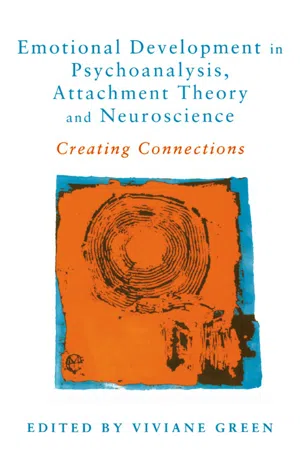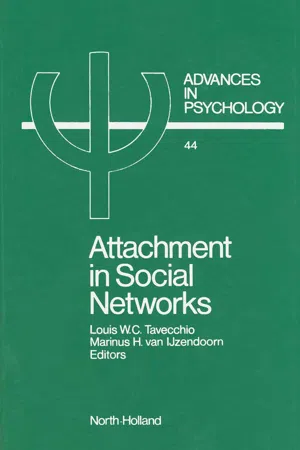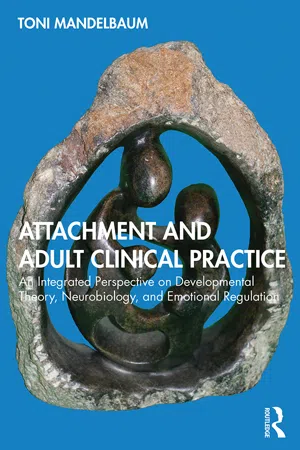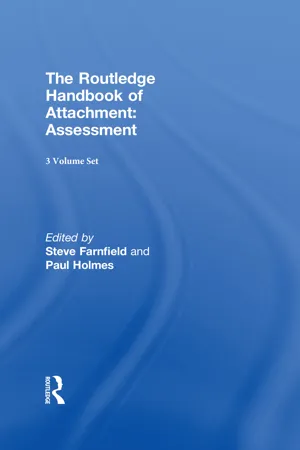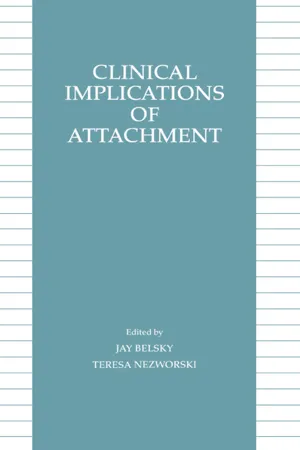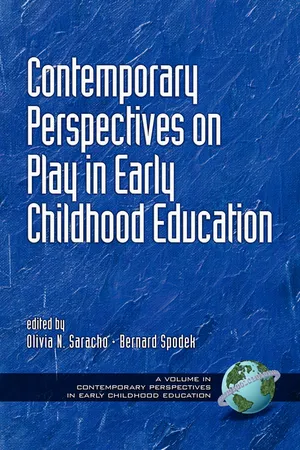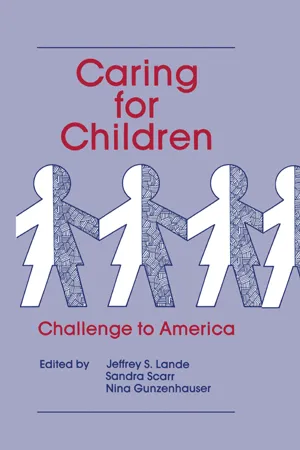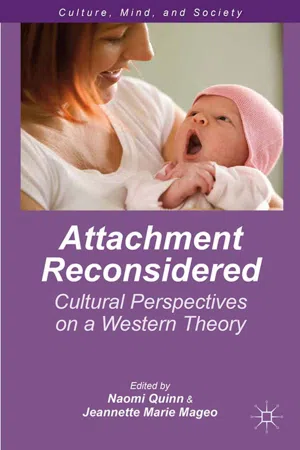Psychology
Ainsworth's Strange Situation
Ainsworth's Strange Situation is a research method used to assess attachment styles in infants. It involves observing how infants react to being separated from and reunited with their caregivers in a controlled environment. The study identified three main attachment styles: secure, insecure-avoidant, and insecure-ambivalent, which have been influential in understanding early childhood development and the parent-child relationship.
Written by Perlego with AI-assistance
Related key terms
1 of 5
11 Key excerpts on "Ainsworth's Strange Situation"
- eBook - ePub
- Robbie Duschinsky, Pehr Granqvist, Tommie Forslund(Authors)
- 2023(Publication Date)
- Routledge(Publisher)
Chapter 1 ), and by encountering a novel – ‘strange’ – environment, also featuring an adult ‘stranger’. The laboratory space also contained various toys, at a little distance from the chair for the caregiver. This was designed as a cue for the child to explore. The infant’s use of the caregiver as a secure base and safe haven could therefore be observed.The Strange Situation was not regarded by Ainsworth as an assessment of a ‘thing’ called attachment. Sometimes it has been discussed this way; at best this is a shorthand, but mostly it is misleading. The Strange Situation sought to mobilise the infant’s expectations based on what has happened when he or she has felt anxiety in the past about the availability of the attachment figure, and allow a viewer to infer these expectations from observed behaviour.The function of the artificial, laboratory-based procedure was to dramatise an everyday issue in the lives of infants: the question of the extent to which their experiences had led them to believe that the caregiver was available when needed. The function of the two separations and reunions was to pose this question first at a low level and then at a moderate level. The Strange Situation therefore assessed the responses of the individual infant; but this was intended, ultimately, as an indirect way of measuring differences in the history of interaction between the child and caregiver. Thus, double inferences from the child’s behaviours are at stake here, that is, to expectations and to caregiving experiences.Most infants responded to the Strange Situation exactly as Bowlby had anticipated. At least by the second separation they sought the availability of their caregiver, and on reunions they could be comforted and return to play. Various attachment behaviours were shown by these infants: they could crawl or waddle to their caregiver on reunion, lift their arms to be picked up, signal with a directed cry, or clamber up onto the caregiver. Closeness with the caregiver was regained when needed, a goal that could be achieved through various means. - eBook - ePub
Attachment Theory
Social, Developmental, and Clinical Perspectives
- Susan Goldberg, Roy Muir, John Kerr, Susan Goldberg, Roy Muir, John Kerr(Authors)
- 2013(Publication Date)
- Routledge(Publisher)
The importance of Ainsworth’s subsequent discovery of qualitative differences in attachment behavior among individuals at (only) 12 months of age cannot be overestimated. In the so-called Strange Situation, the quality of attachment is assessed by what children do to restore a sense of security during reunion with their attachment figures after a brief separation. The children thereby reveal their emergent inner working model of the attachment system, based on what they have learned to expect from many communicative encounters throughout the first year of life. That there might be qualitative, as opposed to simply quantitative, differences in these behaviors upon reunion was unexpected. Yet, in contrast to secure infants, who showed the predicted attachment behaviors upon reunion with their mothers in the Strange Situation, some infants simply avoided their mothers, and others behaved with manifest ambivalence toward them. These surprising, unanticipated findings did not so much contradict Bowlby’s postulate that there was a universal biological propensity toward attachment, as they provided a means for reconciling Bowlby’s conception with empirical differences in sensitivity/insensitivity and other qualities among different mother-child dyads. In essence, Ainsworth and her coworkers had provided irrefutable evidence for the malleability of the attachment system, depending on the differential behavior of caretakers.Ainsworth’s contribution was thus a double one. Beyond the discovery of qualitative differences, her precise and richly descriptive prose describing caretakers’ sensitivity to their babies opened a new way of viewing the intricacies of emotional communication. Forty years earlier, in 1925, Karl Bühler had emphasized the necessity for making the kind of disciplined, systematic observations later accomplished by Ainsworth. Bühler wrote of infant observation:How this is to be done cannot be told in two words and appropriately for all cases. Those interested in a deeper understanding of the most magnificent developmental drama, the becoming human of our children, must recognize that this is impossible to understand without preparation. One must, as in any science and art, learn to see first in order to understand more than a good nanny does. The time when conceptions from popular psychology were still sufficient is definitely over. Even today it seems poor what ingenious pioneers such as Comenius, Rousseau, and Pestalozzi had to say about the first year of life [Bühler, 1925 - eBook - ePub
Emotional Development in Psychoanalysis, Attachment Theory and Neuroscience
Creating Connections
- Viviane Green(Author)
- 2004(Publication Date)
- Routledge(Publisher)
The Strange Situation may thus be said to provide a reliable index of infant behaviour in response to stress-inducing circumstances, and in doing so provides a window upon young children’s internal working models of their relationships to caregivers. That caregivers’ own unique internal working models of relationships, assessed via the AAI, is the most powerful predictor of the infant-caregiver relationship quality further underlines the relationship-specific nature of the attachment construct (see Steele et al. 1996; van Uzendoorn 1995). There have been an enormous number of studies charting the developmental sequelae from Strange Situation assessments in infancy to a variety of social and cognitive developments in toddlerhood, in the nursery years, in latency, in adolescence and most recently into adulthood. The following provides a selected overview of this vast literature on how attachment needs, and resulting actual experience, lead to mental representations (or internal working models) that, in turn, influence subsequent experiences. The longitudinal work of Klaus and Karin Grossmann in Germany has identified long-term implications of early attachment to the mother. One of their many impressive studies showed that securely attached 3-year-old children were able to openly communicate their sadness (looking into the face of their competitor) upon losing a competitive game with an adult examiner. In contrast, those children with an insecure-avoidant history revealed distress when losing but were unable to directly show their sad faces and instead presented a ‘social smile’. These findings map meaningfully onto their independent observation that avoidantly attached 1-year-olds hide their negative feelings while internal indicators as measured by physiological responses in the form of salivary cortisol measurements show intense and prolonged stressful arousal (Spangler and Grossmann 1993) - eBook - PDF
Attachment in Social Networks
Contributions to the Bowlby-Ainsworth Attachment Theory
- L.W.C. Tavecchio, M.H. van IJzendoorn(Authors)
- 1987(Publication Date)
- North Holland(Publisher)
These recent analyses raised important questions regarding the operationalization of attachment behavior and have contributed to sharpening some central questions in attachment theory and research. It is our purpose in the pre- sent study to extend the scope of the discussion by consi- dering dimensions that have not yet been reviewed. In parti- cular we shall focus on issues pertaining to the validity of the Strange Situation outside the United States. 430 A. Sagi arid K.S. Lewkowicz We shall begin by examining various aspects of the distri- butions of classifications deriving from the procedure. These aspects include inconsistencies between and within countries, as well as inconsistencies in the subcategories of the B-type (secure) group. We shall follow with an attempt to provide alternative explanations for these inconsistencies such as the cultural differences in the psychological meaning of the Strange Situation procedure, the problems associated with implementing the procedure, and the problems in applying the classification system. We shall also offer an overview of the contributions of the studies that have assessed antecedents and consequences. Finally, an integrative view will be pro- vided of cross-cultural research in which the Strange Situa- tion procedure was used, and suggestions will be proposed for the directions that research in this area might take in the future. DISTRIBUTIONS OF STRANGE SITUATION CLASSIFICATIONS The vast majority of infants (all of the infants in the Ameri- can samples reported by Ainsworth et al., 1978) can be classi- fied in one of three categories that are based on the pattern of their behavior in the Strange Situation. According to this classification paradigm, the categories reflect secure attach- ments (group B), and two varieties of insecure attachments consisting of avoidant attachments (group A) and resistant attachments (group C). - eBook - ePub
Attachment and Adult Clinical Practice
An Integrated Perspective on Developmental Theory, Neurobiology, and Emotional Regulation
- Toni Mandelbaum(Author)
- 2020(Publication Date)
- Routledge(Publisher)
Additionally, attachment experiences impact the interpretation of social interactions. The lens through which an individual looks at all relationships affects how he or she approaches specific relationships. It is a recursive experience, where expectations of availability or lack of availability can govern an individual’s actions and thereby affect the elicited response. This can be seen in the caregiver–child relationship, where parental sensitivity reinforces a sense of security, which then leads to a child’s responding well to a parent, which encourages the parent to continue to be sensitive (Thompson, 2016). In social situations, for example, an individual who expects to be rejected because of prior experience may retreat from the approach of someone who is trying to befriend him. That can cause the “befriender” to pull back too, and may then be perceived by the “befriendee” as a rejection. This interaction will reinforce that individual’s expectations that he should withdraw in the future because he will be rejected. In other words, security of attachment may not only predict psychosocial outcomes, but may influence or moderate aspects of relationships that may impact outcomes (Thompson, 2016). Because there are multiple factors influencing an attachment relationship, the development of attachment is hardly linear. Overall, it can be viewed as a dynamic, transactional construct, one that influences and is influenced by early and later relationships, family experiences, and social factors (Sroufe et al., 2005b). According to this line of thinking, personality is not predetermined, but shaped by experience and interactions with the environment and according to attachment theory, it is the quality of the attachment relationship in particular that affects development.Summary
Ainsworth’s work was critical to the development of attachment theory. Her Strange Situation was monumental in that it provided a way to measure infant attachment and enabled researchers to contribute to the growing empirical body of knowledge in the field. Ainsworth’s division of attachment into secure, ambivalent, and avoidant was even more monumental, as there was now a more in-depth framework to understand different attachment patterns. And her focus on the construct of maternal sensitivity has also served as a foundation for our understanding of a caregiver’s role in the development of attachment security. The longitudinal studies that emerged because of the work of Bowlby and Ainsworth have allowed us to grasp what underlies optimal socio-emotional functioning. - Paul Holmes, Steve Farnfield, Paul Holmes, Steve Farnfield(Authors)
- 2022(Publication Date)
- Routledge(Publisher)
Ainsworth’s ABC classification system Ainsworth’s classification system was based on infant and mother behaviour dur- ing the Strange Situation procedure (SSP), an observational assessment involv- ing a series of introductions, separations and reunions, designed to activate the infant’s attachment system. The quality of the infant’s interactive behaviour with respect to the caregiver, after two episodes of separation and reunion, were coded on 7-point Likert scales for the presence of the following behaviours: proximity and contact seeking, con- tact maintaining, resistance, avoidance, search behaviours, and distance interac- tion. She later clustered these patterns of dyadic interaction into three categories: Type A (‘avoidant’) characterised by avoidance of proximity or interaction with the caregiver in the reunion episodes; Type B (‘secure’) characterised by the infant actively seeking proximity or contact with his mother, with little demonstration of resistance or avoidance with the mother, and contact with the mother effectively terminating distress; and Type C (‘ambivalent’) with the infant demonstrating 74 Prachi E. Shah and Lane Strathearn both resistance to and initiation of contact and interaction with the caregiver during the reunion episodes (Ainsworth et al. 1978). Type A: avoidant Infant behaviour was labelled as (A) avoidant if they demonstrated conspicuous avoidance of proximity or interaction with the mother in the reunion episodes, characterised by the infant ignoring the mother upon her return, with limited ini- tiation to seek proximity, interact, or maintain contact with the mother. If picked Table 4.1 Summary of episodes of the Strange Situation procedure (Ainsworth et al. 1978: 37) Episode Persons present Duration Brief description of action 1 Mother, baby, & observer 30 sec. Observer introduces mother and baby to experiment room then leaves.- eBook - ePub
- Jay Belsky, Teresa M. Nezworski, Jay Belsky, Teresa M. Nezworski(Authors)
- 2015(Publication Date)
- Routledge(Publisher)
The Penn State Family Intervention Study began in late spring of 1984 as an off-shoot of Belsky’s longitudinal Infant and Family Development Project. All participating parents were working or middle-class, and in intact marriages. That they were highly committed to their children is reflected in their voluntary participation in the longitudinal study for the reported purpose of gaining information about their child’s developmental progress. (See Isabella & Belsky, this volume, for further elaboration of the characteristics of the entire sample.)Pilot Program Design
Infants in this project were regularly assessed at 12 months of age using the standard Ainsworth Strange Situation procedure. When infants in the third cohort of the longitudinal study were classified as insecurely attached (major classification A or C) by two independent raters, the questionnaire, intervention, and observational data gathered on the family from the last trimester of pregnancy through the infant’s ninth month were scrutinized. Our policy was to assign each insecurely attached infant’s mother to an experimental or no-treatment control group if additional evidence of stress, other than attachment classification, could be found in the data gathered prior to the Strange Situation assessment. In each and every case, corroborative evidence of difficulty in the personality or family system of the mother was in evidence. For instance, in one case, the questionnaire data on child-rearing history revealed that the mother perceived her parents love for her to be totally conditional, based primarily on her achievements in school and other specified areas. In another identified case, a review of responses to questions concerning social support showed that the mother felt isolated except for her neighboring mother-in-law, who she experienced as critical and rejecting. In a third case, marital adjustment questionnaire responses indicated a pattern of increasing conflict and hostility.A total of 31 infants were classified as insecure (16 A’s, 15 C’s). Four families moved out of the area shortly after the assessment at 1 year and became unavailable for further study (1 A, 3 C’s). Of the remaining insecure sample, 14 were invited to participate in the clinical treatment phase (8 A’s, 6 C’s). - eBook - PDF
Child Psychology
Development in a Changing Society
- Robin Harwood, Scott A. Miller, Ross Vasta(Authors)
- 2012(Publication Date)
- Wiley(Publisher)
Typically, we would expect that, although an infant may accept contact from the stranger, this contact will not be truly effective in restoring the child’s sense of security. 7. Episode 7: The mother returns and the stranger leaves. As in Episode 4, of interest here is how the child responds to the mother’s return. If the baby is distressed, does he or she seek contact with the mother? Does that contact serve to comfort him or her? If the baby is not distressed, does he or she greet the mother enthusiastically, happy for her return? Based on her observations of infants both at home and in the Strange Situation, Ainsworth (1967) identified three major patterns in the quality of attachment relation- ships that infants have with their parents or other primary caretakers: secure attachment (Group B), avoidant attachment (Group A), and ambivalent or resistant attachment (Group C). 1. A securely attached (Group B) infant is able to use the mother as a secure base from which to explore unfamiliar areas, objects, or people. If distressed by the separations, the securely attached infant seeks contact with the mother and is comforted by that con- tact. If not distressed, the securely attached infant greets the mother happily when she returns. In the United States, researchers have generally found that 60 to 70 percent of infants in low-risk, middle-class families are securely attached to their parents. 2. Infants who have an avoidant attachment (Group A) re- lationship show little distress during the separations, and when distressed they are easily comforted by the stranger. When the mother returns, they turn away from her and avoid contact with her rather than either greeting her happily or seeking comfort. 3. Infants who have an ambivalent or resistant attachment (Group C) relationship are extremely distressed by the separa- tions, but seem unable to gain comfort from the mother when she returns. They continue to cry and will also express anger toward the mother. - Olivia Saracho, Bernard Spodek(Authors)
- 2015(Publication Date)
- Information Age Publishing(Publisher)
In support of this aforementioned theory, attachment researchers have posted an impressive array of reliability and validity work on both the Strange Situation, as well as methodologies designed to capture working models of attachment in older populations (e.g., Adult Attachment Inter-view; George, Kaplan, & Main, 1996). Infant attachment classifications are relatively stable over time, and predict many important outcomes during childhood and adolescence, such as social competence in the peer group, the ability to cope with stress, psychological health, and school adjustment (see Thompson, 1999 for a comprehensive review). In addition, parent working models of attachment assessed prenatally forecast eventual infant-parent attachment (e.g., Benoit & Parker, 1994). Finally, infant attachment classifications, as assessed via the Strange Situation, have been shown to longitudinally predict adult working models of attachment (Waters, Wein-field, & Hamilton, 2000). Having briefly outlined the major tenets of attachment theory, we next turn to theory suggesting important connec-tions between the development of attachment, infant exploration, and the development of early object play. ATTACHMENT PERSPECTIVES ON EXPLORATION AND PLAY Bowlby remarks in a number of works that children's play, like attachment, is a universal phenomenon that can be witnessed across both human and nonhuman species. His perspective on the development of children's play was quite clear and unidirectional in nature. It was Bowlby's (1988) premise that exploration, competent play, and mastery of the environ-ment—major fundamental milestones during early childhood (Erikson, 1950; Mahler, Pine, & Bergman, 1975)—only can occur when the child feels secure in relationships with caregivers. Additionally, attachment inse-curity can only dampen these activities (cf. Ainsworth et al., 1978).- eBook - ePub
Caring for Children
Challenge To America
- Jeffrey Lande, Sandra Scarr, Nina Guzenhauser, Jeffrey Lande, Sandra Scarr, Nina Guzenhauser(Authors)
- 2014(Publication Date)
- Psychology Press(Publisher)
Because developmentalists continue to debate the meaning of heightened avoidance and the use of the Strange Situation with infants with extensive day care experience, it is useful to consider the kind of evidence that would confirm the ideologically attractive, scientifically plausible, yet empirically unsubstantiated contention that it is inappropriate to compare children who vary in their routine experience with infant-parent separation by using a procedure that is designed around normatively stressful encounters with strangers and separations. Most compelling would be evidence that so-called “true” avoidance can be distinguished from “true” independence, because it is the contention of some that the latter is confused with the former in the case of infants with extensive day care experience, and that such infants are actually more independent but no more avoidant than infants with fewer than 20 hours per week of nonmaternal care. Also significant would be evidence that the developmental sequelae of secure and insecure attachments—especially of insecure attachments—as measured by the Strange Situation differ in home-reared infants and infants with extensive nonmaternal care, indicating that what has been classified as insecure behavior in the latter group reflects something different from what it reflects among infants reared exclusively at home by their mothers. Finally, evidence indicating that infants with extensive day care are less stressed, particularly at the hormonal level (e.g., cortisol), by the Strange Situation than are infants with little or no nonmaternal care would also raise serious questions about the appropriateness of this research paradigm for understanding the developmental correlates of extensive day care in the first year of life. Evidence consistent with any one of these considerations would seriously undermine the previous conclusion that extensive nonmaternal care initiated in the first year of life is associated with heightened risk of insecure infant-parent attachment; evidence consistent with all three considerations, moreover, would convincingly demonstrate that comparative studies of infants with varying day care experience using the Strange Situation are totally uninterpretable.In view of the fact that the critical studies have yet to be conducted, even though alternative interpretations of avoidance and criticism of the use of the Strange Situation in the case of day care–reared children have been advanced since at least 1983 (Clarke-Stewart & Fein, 1983), there are three basic reasons why the concerns currently raised about the interpretation of the association between extensive infant day care and insecure infant-mother attachment remain unconvincing. And these, it should be noted, go beyond Sroufe, Fox, and Pancake’s (1983) demonstration that the so-called precocious independence displayed by infants classified as insecure-avoidant forecasts later dependence during the preschool years, as a dynamic transformational theory of development would suggest, rather than independence, as advocates of the avoidance = independence position would predict. The first to be considered deals with similarities in the preschool functioning of children with extensive day care in their first year and of children with insecure-avoidant attachment histories; the second with the differential rates of insecurity discerned in the prenatally and postnatally recruited families with full-time working mothers in the Chase-Lansdale and Owen investigation; and the third with infant, maternal, and family characteristics that distinguish secure and insecure infant-mother attachment relationships in the case of infants with extensive day care experience. - eBook - ePub
Attachment Reconsidered
Cultural Perspectives on a Western Theory
- N. Quinn, J. Mageo, N. Quinn, J. Mageo(Authors)
- 2013(Publication Date)
- Palgrave Macmillan(Publisher)
Indeed, the “proximal” modes of interaction that Japanese mothers use with their infants make it practically impossible for these infants to avoid their mothers. The emphasis on harmony is a feature of the “cultural model of virtue” shaping Japanese child-caregiving practices. In contrast, in the American cultural model, “social independence or self-reliance is emphasized in the child’s development,” and even infants are encouraged to cope with being alone and to explore their environments on their own at a distance from the caregiver (Takahashi 1990:29). The divergent cultural meanings embedded in these practices are learned early.Acknowledging that “There is no doubt that cultural factors constrain performance on social assessments like the Strange Situation,” Miyake et al. (1985:294) conclude, “Thus we do not consider the classification of Japanese infants as C [resistant] to be ‘insecurely attached.’ ” Takahashi (1990:28–29), however, is not so willing to concede the cultural relativism of attachment security and insecurity, insisting in the end that avoidant infants are to be found among Japanese populations, if only the diagnostic criteria be sensitive enough to identify them:In light of Japanese customs, avoidant behaviors, even when they are subtle, may be critical and thus should be given important diagnostic value, because avoidance goes against the grain of the culture. By modifying the criteria behaviors, we can identify at least some type A [avoidant] subjects among Japanese infants.This insistence, that avoidant Japanese subjects are to be found if only sensitive enough criteria are used to identify them, seems to us to reflect a general tendency of psychologists to grant more credence to preexisting analytic categories than to field observations.The major critique of these conclusions as to Japanese attachment comes from Fred Rothbaum and his colleagues (Rothbaum et al. 2000, 2011). As in LeVine and Norman’s critique of the Bielefeld study, the issue is once again cultural context. Rothbaum and his colleagues make the insightful observation that the context of attachment has largely been ignored by theorists for the reason that “they, and the people they studied, were not themselves highly context dependent” (Rothbaum et al. 2011:154). These authors go on to propose that attachment and learning are related, and vary together across communities. For many American parents and children considered middle class, attachment and learning center on autonomous exploration. The qualities that promote this general orientation, such as individual accomplishments, self-confidence, and self-initiation, are encouraged and valued. Within many Japanese communities, by contrast, attachment and learning center on ways of harmonizing with others and adjusting to the social situation in which one finds oneself, as Takahashi has described. The qualities that promote this orientation, such as imitation, adherence to prescribed roles, and self-criticism, are encouraged and valued. These are two starkly different cultural models of virtue.
Index pages curate the most relevant extracts from our library of academic textbooks. They’ve been created using an in-house natural language model (NLM), each adding context and meaning to key research topics.


